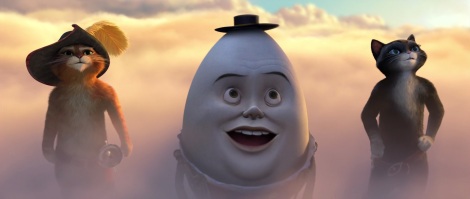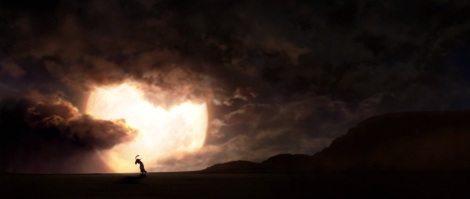The smirk factory known as DreamWorks Animation is responsible for the most successful animated franchise of all time (i.e. the 21st century, since the concept of an “animated franchise” didn’t really exist before then). When Shrek was released in 2001, the nursery-room-mishmash-as-interpreted-by-snarky-fratboys was generally admired as a stink bomb aimed at Disney. So lucrative were the film and its sequels that they launched a theatrical spinoff in 2011. My family and I showed up for Puss in Boots on opening weekend and thoroughly enjoyed ourselves. I held back a little, giving the film the dreaded 3 ½ stars. My opinion at the time was that, although the movie was quite funny, its story didn’t capture my imagination. I felt that it suffered by comparison with the other animated spaghetti western homage from that year, Rango (remember Rango?), using the genre as just another launchpad for jokes rather than a framework. Generally speaking, the Shrek films seem destined to be remembered as products of their time. With Puss in Boots, the opportunity arose for the filmmakers to take a different approach. I’ve casually revisited the film a couple times over the years, but I hoped that a close watch would give me a firmer grasp on my feelings toward it.
The Revisit
It’s an origin story. If there’s one thing that fifteen-plus years of Hollywood franchises have taught us, it’s that no matter how uninteresting the origin stories of beloved characters happen to be, the studios will continue feeding them to us. And Puss in Boots was very much beloved. A secondary character introduced in Shrek 2, the swashbuckling tabby cat was voiced by Antonio Banderas, who had already played Zorro in live action and so knew exactly what tone the role called for. He gives the character boundless charm, and cats are incredibly cute. This isn’t rocket science. In the film, Puss is revealed to have grown up in an orphanage, where he befriended a talking egg by the name of Humpty Dumpty (voiced by Zach Galifianakis and given an ordinary middle name, humorously). Both were regarded as freaks by the humans who surrounded them, but Humpty had a much rougher time of it, leading him down a path of bitterness despite Puss’s attempts to encourage him. The ups and downs of their relationship form the foundation for the main plot.
Typical of the franchise, this film is a pastiche of characters who are all deeply ingrained in the West’s collective memory, although the average person has probably never given a moment’s thought to Jack and Jill outside of the hill, the pail, the tumbling, and the crown. In this telling, they are two gruff outlaws in search of the treasure of another Jack who climbed a beanstalk. Puss, a wanted man himself, is in search of the same thing. As it happens, so is Humpty, but the two old friends only join forces reluctantly. Both feel betrayed by the other owing to the ill-fated bank robbery that first drove them apart. Humpty says he’s changed, however, and Puss wants to believe him. Capers, unmaskings, and recriminations ensue.
 Thankfully, this film is largely free of Shrek effluvia. Besides one prison-rape joke, the humor is pretty much entirely inoffensive. The Puss-Humpty dynamic is unexpected and salutary, even though there’s no real logic to it other than the lazy “fairy tale characters are outcasts” idea. Best of all is the rivalry/romance between Puss and Kitty Softpaws (Salma Hayek), with a pickpocketing-as-foreplay element that hearkens all the way back to Ernst Lubitsch’s Trouble in Paradise. Their shared athleticism contributes to the visual highlight of the film, a canyon chase to swipe the magic beans from Jack and Jill. Things can only get less interesting from that point on, as the trip up the beanstalk yields the expected risks and rewards, and Humpty hits all the expected beats. The identity of the “Great Terror” that is the climactic threat is kept secret for a long time even though it should be easy for anyone to guess. In short, the story still doesn’t fascinate me.
Thankfully, this film is largely free of Shrek effluvia. Besides one prison-rape joke, the humor is pretty much entirely inoffensive. The Puss-Humpty dynamic is unexpected and salutary, even though there’s no real logic to it other than the lazy “fairy tale characters are outcasts” idea. Best of all is the rivalry/romance between Puss and Kitty Softpaws (Salma Hayek), with a pickpocketing-as-foreplay element that hearkens all the way back to Ernst Lubitsch’s Trouble in Paradise. Their shared athleticism contributes to the visual highlight of the film, a canyon chase to swipe the magic beans from Jack and Jill. Things can only get less interesting from that point on, as the trip up the beanstalk yields the expected risks and rewards, and Humpty hits all the expected beats. The identity of the “Great Terror” that is the climactic threat is kept secret for a long time even though it should be easy for anyone to guess. In short, the story still doesn’t fascinate me.
Unfortunately, I found that the overall experience followed suit this time around. There’s something about a DreamWorks film that makes it seem less like a cohesive creation and more like a collection of attempts to capitalize on the meme-ification of pop culture. The cat that goes “Ohhhh!!!!” in this, like the sloth that goes “Dun, dun, DUN!!!!” in The Croods, is a glaring if minor example, but the rest of the film struggles to feel necessary, too. There are some beautiful computer-generated images in this movie — the castle in the clouds is stunning — but the artists are neither totally invested in the mythologies they’re playing with, nor totally frivolous with them as in Shrek or Disney’s The Emperor’s New Groove. The middle ground, while it’s the safest place to be, is also blah.
The Verdict
While the general brashness of the filmmaking made me hungry for some Miyazaki, Puss in Boots is still a mostly pleasant means of whiling away an hour and a half. There’s still the feline musketeer womanizer himself, a breakout star whose popularity makes complete sense to me, unlike a certain band of yellow pill-people. To date, this is the last Shrek-related film to appear in theaters, and although a sequel is still planned for (gulp) 2018, the time may have come for the franchise to be laid to rest. By “laid to rest,” of course, I mean “quietly forgotten until the next wave of nostalgia hits, bringing with it a new trilogy and an expanded universe.” We’ll look back and say, “At least the first Puss in Boots told a self-contained story.” Three stars.

